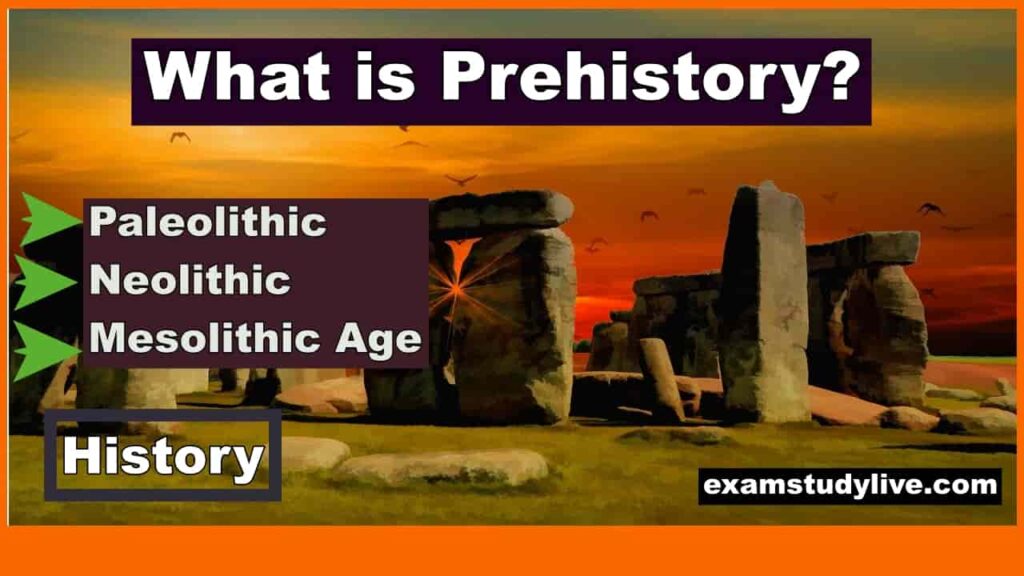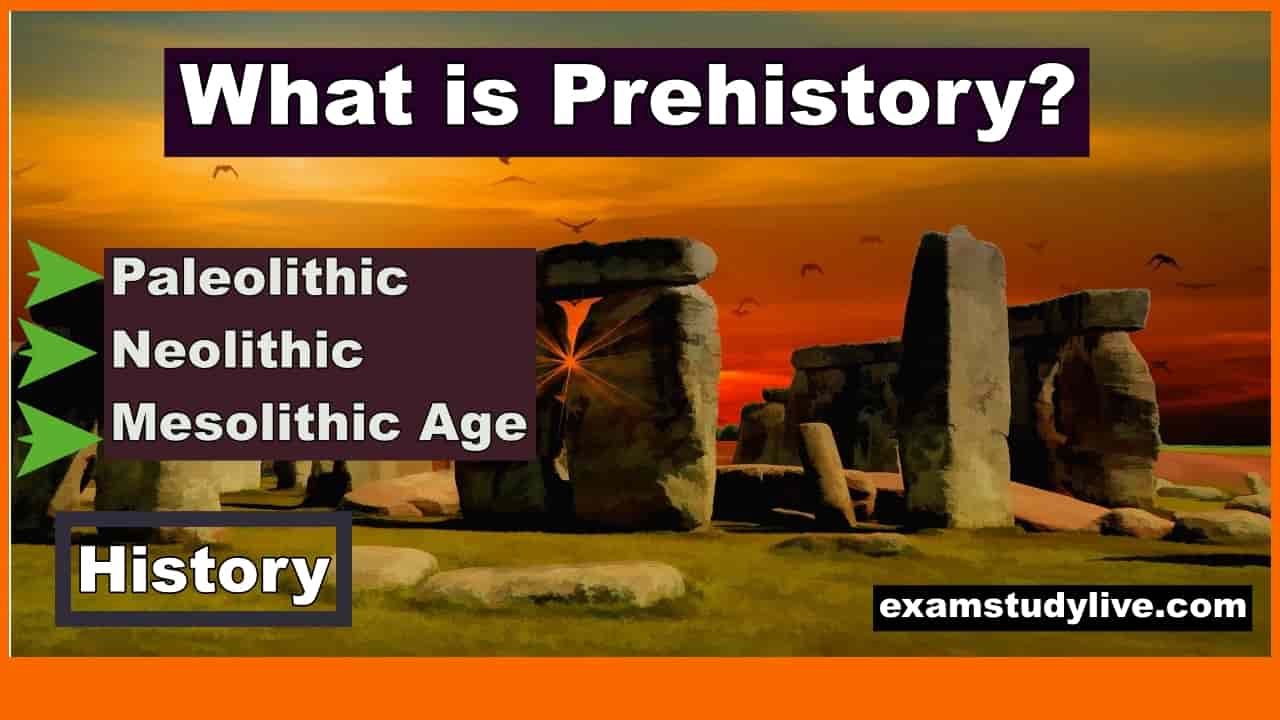In this article, you get complete brief notes about What is Prehistory – Paleolithic, Neolithic & Mesolithic Age Notes with Indus valley civilization.

What is Prehistory?
The study of the history of mankind from the time of emerging from animal ancestry to the time of written history is called Pre-history.
Father of Pre-history – Robert Bruce Foote (British geologist) Father of history – Herodotus. Human being created 15,00,000 years ago. But a human being existence in India 5,00,000 years ago. Human beings started written -5,000 years ago. History started writing 2,500 years ago.
The total time span in India divided into:
1. Palaeolithic age
2. Mesolithic age
3. Neolithic age
(What is Prehistory – Paleolithic, Neolithic & Mesolithic Age Notes)
PALAEOLITHIC AGE (5,00,000 BC-10,000BC)
It is also known as Old Stone Age.
- The people of this age were food gatherer & lived on hunting.
- Man during this period used tools of unpolished, undressed, and rough stones.
- The tools were made of hard rock known as Quartzite
- The people of this period called – Quartzite man.
- The greatest invention of this period is fire.
- They had no knowledge of fire, agriculture, and pottery.
Sohan Valley Punjab, Chittaurgarh and Kota of Rajasthan, Sirsa of Haryana, river Sabarmati and Mahi basin of Rajasthan and Gujarat are some important sites of the Palaeolithic age. Bhimbetka of Madhya Pradesh is the most important site of the Palaeolithic age.
Again Palaeolithic divided into
1. Early Paleolithic age
2. Middle paleolithic age
3. Upper Palaeolithic age
Also Read 8 Fastest Way To Get A Job | How To Get A Job Fast
MESOLITHIC AGE (10,0008 C-6,000 B C)
Also called the Late Stone age or Middle Stone Age They had also food gathering but advanced, Hunting (Advanced), fishing was there during this age The last phase of this age saw the beginning of domestication of animals and cultivation. Area: Narmada valley(Gujarat), Vindhya Mountain(Madhya Pradesh) The first microlithic was discovered by Carlyle in 1867.
NEOLITHIC AGE
Also known as New Stone Age.
- They had Knowledge of cultivation
- Knowledge of making a house by mud
- Knowledge of pottery (first by hand than by a wheel)
- Knowledge of domestication. Sheep was the animal domesticated.
- The tools used by them were more polished.
- The area covered: Sindh, Kashmir, Bihar
CHALCOLITHIC AGE
Also called the Copper-Stone age Knew the domestication of animals like sheep, goats, cow pig, and buffalo.
- Lived in mud and thatched house. Didn’t use burnt bricks. Lived on cultivation and produced wheat and rice.
- Used potteries of black and red colors. Worshiped mother deities – Terracota figure of the woman
- They used tools made of copper and stone
- Area: Rajasthan, Maharashtra, MP, and Bihar
INDUS VALLEY CIVILIZATION (2500 BC-1750BC)
It is also called Harappan civilization. Saraswati-Sindhu Civilization and Ghaggar-Hakra civilization.
Geographical Extent
Punjab, Sindh, Gujarat, Rajasthan, Western UP. Northern Maharashtra Haryana, Jammu and Kashmir with Baluchistan.
Important sites of Indus Valley Civilization
SITES IN PAKISTAN
Harappa, Mohenjadaro, Chanhudaro, Suktagandor. Kot Diii and Amri
SITES IN INDIA
Kalibangan, Rajasthan, Banwali, Haryana. Rakhigarhi. Haryana & Alamgirpur(UP)
HARAPPA
It was Excited in 1921. It was e executed by Dayaram Sahani It is situated on the riverbank of Ravi in Montogomery Pakistan. It is known as a gateway city. Granny and coffin burial is important evidence of Indus Valley Civilisation.
MOHENJADARO
It was excavated in 1922. Excavated by R.D Benerjee. It is situated on the riverbank of Sindhu (Indus). It is known as “Mound of Dead” Famous for – Great bath, Great Grannery & Bronze dancing girl with Seal of Pashupati
OTHER IMPORTANT SITES WITH EVIDENCE
Kalibangan is known for Bangle city and plough field, Lothal famous for dockyard Chanhudaro – City without citadel, Surkotoda – Bones of the horse and Dholavira – a unique water harnessing system.
SOCIETY
The society of IVC was an urbanized society
The main crops were wheat and barley The other crops were dates, mustard, and cotton, The Indus people were the first to produce cotton in the world. The Indus people knew sheep. goat. Bull. buffalo dop. cat. pip. deer. elephant. camel. rhinoceros. tiger, but not a lion.
There was systematic town planning in Indus Valley Civilisation. They used burnt bricks in construction. There was an underground drainage system. There was a fortified citadel except for chanhudaro. They worshipped pipal tree, bull, dove &, pigeon The chief male deity was – Pashupati Mahadeva (The lord of animals).
The swastika symbol is the greatest contribution of the Indus Valley Civilization. There was no evidence of coin but evidence of barter system. They knew weight and measurement system 16 was the unit of measurement.
They had a foreign trade relationship with Mesopotamia or Sumeria and Bahrain. The contemporary civilization of IVC was Mesopotamia, Egypt, and China.
The Indus valley people knew gold, copper, bronze silver but not iron. The script of IVC was undeciphered, but there was an overlapping of letters written from right to left in the first line and left to right in the second line. It is known as – Boustrophedon.
(What is Prehistory – Paleolithic, Neolithic & Mesolithic Age Notes)
Also read

